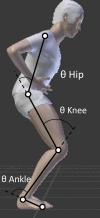Age-related differences of inter-joint coordination in elderly during squat jumping
- PMID: 31498811
- PMCID: PMC6733476
- DOI: 10.1371/journal.pone.0221716
Age-related differences of inter-joint coordination in elderly during squat jumping
Abstract
Background: Explosive movement requires that the individual exerts force and power with appropriate magnitude and timing. These coordination aspects have received less attention despite being a basic prerequisite for daily mobility and physical autonomy, especially in older people. Therefore, the purpose of this study is to characterize the effect of age on inter-joint coordination during explosive movement.
Methods: Twenty-one elderly and twenty young participants performed three maximal vertical jumps, while kinematics were recorded throughout each squat jump. Inter-joint coordination and coordination variability were calculated for selected sagittal hip-knee, knee-ankle, and hip-ankle joint couplings using the continuous relative phase method.
Results: The young participants produced significantly greater jump height performance (0.36 ± 0.07 m vs. 0.12 ± 0.04 m, p < 0.001). The mean absolute continuous relative phase for ankle-knee and knee-hip joint couplings were significantly greater for the elderly in comparison to the young group (p < 0.01 for the both). No significant differences between senior and young participants in the mean absolute continuous relative phase for ankle-hip joint couplings (p = 0.25) was observed. However, there was significantly more variability in inter-joint coordination in the elderly marked by greater continuous relative phase variabilities in ankle-knee, ankle-hip and knee-hip joint couplings (p < 0.001) than those observed in young adults.
Conclusion: In this study, seniors demonstrated proximodistal inter-joint coordination but with different delays in the pattern of inter-joint coordination during squat jumps compared to young adults. In addition, a higher continuous relative phase variability in the elderly may be needed to improve stability or compensate for strength deficits in jump achievement.
Conflict of interest statement
The authors have declared that no competing interests exist.
Figures



Similar articles
-
Explosive movement in the older men: analysis and comparative study of vertical jump.Aging Clin Exp Res. 2017 Oct;29(5):985-992. doi: 10.1007/s40520-016-0660-0. Epub 2016 Nov 14. Aging Clin Exp Res. 2017. PMID: 27844453
-
Vertical jumping reorganization with aging: a kinematic comparison between young and elderly men.J Appl Biomech. 2005 Aug;21(3):236-46. doi: 10.1123/jab.21.3.236. J Appl Biomech. 2005. PMID: 16260844
-
Asymmetry of Inter-joint Coordination during Single Leg Jump after Anterior Cruciate Ligament Reconstruction.Int J Sports Med. 2017 Feb;38(2):159-167. doi: 10.1055/s-0042-109976. Epub 2016 Dec 16. Int J Sports Med. 2017. PMID: 27984842
-
Contributions to the understanding of gait control.Dan Med J. 2014 Apr;61(4):B4823. Dan Med J. 2014. PMID: 24814597 Review.
-
A guide to inter-joint coordination characterization for discrete movements: a comparative study.J Neuroeng Rehabil. 2023 Sep 30;20(1):132. doi: 10.1186/s12984-023-01252-2. J Neuroeng Rehabil. 2023. PMID: 37777814 Free PMC article. Review.
Cited by
-
The Impact of 8 Weeks of Combined Physical Exercise Training on SIRT3 and mTOR in Lymphocytes, and on Lipid Peroxidation.Healthcare (Basel). 2024 Jan 30;12(3):350. doi: 10.3390/healthcare12030350. Healthcare (Basel). 2024. PMID: 38338233 Free PMC article.
-
Structural and Functional Changes in the Coupling of Fascial Tissue, Skeletal Muscle, and Nerves During Aging.Front Physiol. 2020 Jun 24;11:592. doi: 10.3389/fphys.2020.00592. eCollection 2020. Front Physiol. 2020. PMID: 32670080 Free PMC article. Review.
-
Interjoint Coordination at Different Squatting Speeds in Healthy Adults.Cureus. 2024 Aug 23;16(8):e67620. doi: 10.7759/cureus.67620. eCollection 2024 Aug. Cureus. 2024. PMID: 39310612 Free PMC article.
References
-
- Rittweger J, Schiessl H, Felsenberg D, Runge M. Reproducibility of the jumping mechanography as a test of mechanical power output in physically competent adult and elderly subjects. Journal of the American Geriatrics Society. 2004;52(1):128–31. Epub 2003/12/23. 52022 [pii]. 10.1111/j.1532-5415.2004.52022.x . - DOI - PubMed
-
- Runge M, Rittweger J, Russo CR, Schiessl H, Felsenberg D. Is muscle power output a key factor in the age-related decline in physical performance? A comparison of muscle cross section, chair-rising test and jumping power. Clinical Physiology and Functional Imaging. 2004;24(6):335–40. Epub 2004/11/04. 10.1111/j.1475-097X.2004.00567.x . - DOI - PubMed
-
- Rantanen T. Muscle strength, disability and mortality. Scandinavian Journal of Medicine & Science in Sports. 2003;13(1):3–8. Epub 2003/01/22. . - PubMed
-
- Rantanen T, Avlund K, Suominen H, Schroll M, Frandin K, Pertti E. Muscle strength as a predictor of onset of ADL dependence in people aged 75 years. Aging clinical and experimental research. 2002;14(3 Suppl):10–5. Epub 2002/12/12. . - PubMed
-
- Trombetti A, Reid KF, Hars M, Herrmann FR, Pasha E, Phillips EM, et al. Age-associated declines in muscle mass, strength, power, and physical performance: impact on fear of falling and quality of life. Osteoporosis international. 2016;27(2):463–71. Epub 2015/07/22. 10.1007/s00198-015-3236-5 - DOI - PMC - PubMed
Publication types
MeSH terms
LinkOut - more resources
Full Text Sources
Medical

